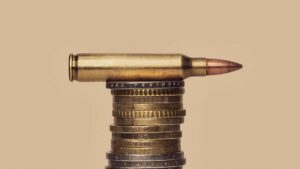Ten Bagger: Tin’s fundamentals are still striking for John Forwood

Tin continues to run hot and travel under the radar. Pic: Supplied/Stockhead
Welcome to Ten-Bagger, where Lowell Resources Fund chief investment officer John Forwood gives us his take on a sector of the ASX resources market full of value.
This month, John talks his conviction in the tin market.
Tin is a small market. At around 350,000tpa of demand, the trade in tin close to 100 times lighter than copper and 10 times smaller than nickel.
But it’s no less important when it comes to the future of energy.
Miniaturisation hurt tin prices as hand-held devices got smaller and their components more efficient over the course of this century, over half of the end user market coming from the solder that glues together electronic circuit boards.
But rising technologies like electric vehicles, battery storage and AI have ensured demand is now on a solid platform.
At the same time, supply has been fragile with Indonesia and Myanmar’s large alluvial deposits subject to environmental crackdowns and few new hard rock mines brought online in recent years.
While tin remains niche and will never be a big part of the Lowell Resources Fund (ASX:LRT) portfolio, its chief investment officer John Forwood says strength in the tin price – US$33,805/t today – and those fundamentals make it a market to watch closely.
“Rule of thumb, what I work on is tin is worth 3x as much as copper,” Forwood said.
“Half a percent tin grade is one and a half percent copper equivalent, or slightly better at the moment.
“Tin recoveries generally are significantly lower – if you’re in the 70s you’re happy but you probably wouldn’t be happy getting that from a copper flotation plant. So there are some differences.
“(But) the demand side and the price response in a long-term sense is very good for tin (and) the supply side is where it gets a little murky.”
That’s a great fundamental setup for continued price strength, with China, Indonesia and Myanmar all countries with a lack of transparency when it comes to the status of their operations.
Market movements
Prices were spurred on by a clampdown on alleged illegal mining and the confiscation of five private smelters in Indonesia last year, although the conclusion of a long-running corruption investigation has stirred strong exports out of the South-East Asian nation in 2025.
Myanmar’s autonomous Wa State has also recently announced the award of licences after a two year ban, alleviating supply constraints for refiners in China.
But prices remain strong, an indication customers are still concerned about their ability to ensure a stable source of supply.
Forwood says it’s a “head scratcher” as to why there haven’t been more tin mines opened in recent years with prices at historically strong levels.
The high-grade Bisie tin mine in the Democratic Republic of the Congo was the last hard rock operation of substance to open in 2018, and caused a supply shock when the temporary takeover of North Kivu province by Rwanda-backed M23 rebels prompted a short-lived closure earlier this year.
A couple are still waiting in the wings.
“The Achmmach project in Morocco, it was Kasbah Resources and now it’s been privatised, that’s moving towards production but that’s been 15 years that’s been talked about in feasibility terms,” Forwood said.*
“The Heemskirk tin project in Tassie (owned by Stellar Resources (ASX:SRZ) ), it’s been a long time trying to get that to a critical point into production.”
*Majority owner Atlantic Tin was recently acquired by Hong Kong based Xingye.
Sky’s the limit
Forwood’s stock of choice in the ASX tin market is Norm Seckold-chaired explorer Sky Metals (ASX:SKY).
It owns two tin projects in historic alluvial fields in New South Wales.
The first priority is Tallebung, a historical mine site near Condobolin which sits to the south of Aurelia Metals’ (ASX:AMI) Peak and Hera gold-copper mines.
The second is Doradilla, located to the south of Bourke in the state’s northwest.
Tallebung is the most advanced, carrying a resource of 15.6Mt at 0.15% Sn and 0.03% WO3 for 23,200t tin and 433,940mtu of tungsten trioxide.
An exploration target has also been posted of 23-32Mt at 0.14-0.17% Sn. It seems low grade, but Sky thinks it may have cracked a long-running processing challenge at the project by testing Tomra ore-sorters to upgrade the material.
“It does seem to be exceptionally responsive to XRF ore sorting, the Tomra technology. I went up and had a look at their pilot plant in Sydney at Castle Hill. It’s quite remarkable,” Forwood said.
“Obviously it doesn’t sort the fines component, but depending on where they set the dial, to put it in very simplistic terms … they can increase the grade by more than 5x.
“So it means you’re going from a 0.2-odd per cent head grade to a 1% head grade.
“If you think of that in copper terms, it’s 3% copper, roughly, and treating a fifth of the amount of ore that actually gets mined.”
The trick will be to see if works on a commercial scale, but Forwood is also optimistic about the growth potential of the deposit, with drilling funding extensions to the tin resource as well as high grade silver around its edges.
Seckold, best known as the chair of Indonickel giant Nickel Industries (ASX:NIC) and also the chair of billion dollar critical minerals play Alpha HPA (ASX:A4N), is joined on the company’s board by young geologist Olly Davies as MD, former Aurelia MD Rimas Kairaitis and exploration veteran Richard Hill, most recently chair of the board of copper developer New World Resources (ASX:NWC) ahead of its takeover by Kinterra Capital.
Related Topics

UNLOCK INSIGHTS
Discover the untold stories of emerging ASX stocks.
Daily news and expert analysis, it's free to subscribe.
By proceeding, you confirm you understand that we handle personal information in accordance with our Privacy Policy.








